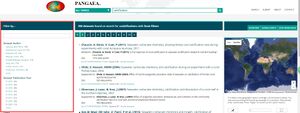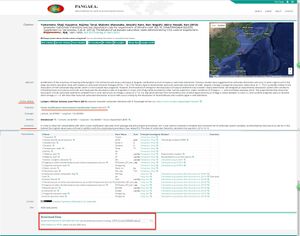Project data management/OA-ICC: Difference between revisions
Sschumacher (talk | contribs) No edit summary |
|||
| (173 intermediate revisions by 3 users not shown) | |||
| Line 1: | Line 1: | ||
== Abstract == | |||
The uptake of anthropogenic CO<sub>2</sub> by the oceans leads to a rise in the oceanic partial pressure of CO<sub>2</sub> (''p''CO<sub>2</sub>), a decrease in ocean pH (the so-called ocean acidification), and a decrease in ocean carbonate ion concentration. Numerous papers report the effects of ocean acidification on marine organisms and communities, but in inconsistent units or scales. Sometimes, data not relevant for the paper but possibly relevant for comparative studies are not included in the publications. Hence direct comparison of results of different studies has often been difficult. | |||
In response to this problem, a data compilation on the biological response to ocean acidification was launched in 2008 by the EU projects [http://www.eur-oceans.eu EUR-OCEANS] and [http://www.epoca-project.eu EPOCA]. This effort ended in 2012 with the end of EPOCA but is now resuming in the framework of the International Atomic Energy Agency (IAEA) project '''Ocean Acidification International Coordination Centre''' ([http://www.iaea.org/ocean-acidification OA-ICC]). | |||
== What kind of data is included in the data compilation of the Ocean Acidification International Coordination Centre ([http://www.iaea.org/ocean-acidification OA-ICC])? == | |||
The OA-ICC data compilation includes data from published papers studying the '''biological response to ocean acidification'''. In order to be included in the compilation, the papers must contain information on at least two variables of the carbonate system as well as salinity and temperature. The carbonate chemistry for all data sets has been recalculated using the [http://CRAN.R-project.org/package=seacarb R package seacarb]. All the datasets of the OA-ICC and the EPOCA/EUROCEANS compilation (2008- 2012) have been given the tag “Ocean Acidification International Coordinate Centre ([http://www.iaea.org/ocean-acidification OA-ICC])” in the data library [http://www.pangaea.de PANGAEA®] - Data Publisher for Earth & Environmental Science operated by [http://www.awi.de Alfred Wegener Institute] in Bremerhaven, Germany (shown under the '''[http://www.pangaea.de/projects/ Project table]'''). | |||
== How to search the data compilation == | |||
[ | Go to '''[http://oa-icc.ipsl.fr/ Data portal]''' of the [http://www.iaea.org/ocean-acidification OA-ICC] webpage or to [http://www.pangaea.de PANGAEA®] - Data Publisher for Earth & Environmental Science | ||
[[Image:Example.jpg|thumb|Figure 1- Screenshot of simple search on the Pangaea webpage]] | |||
'''Simple search''' | |||
Enter the title of papers, authors or the project name “OA-ICC” in the search field and click on the Search button to get a list of datasets (fig. 1). The simple search is operating like Google. Then filter these datasets by clicking “OA-ICC” under '''Project''' in the facetted search which are shown on the left column of the webpage. You can further filter these datasets by Dataset Author, Dataset Publication Year and Location using the facetted search or by Temporal coverage and Geographic coverage using the map on the right column of the webpage (fig. 2). | |||
Examples: | |||
Search: calcification and filter by Project: OA-ICC | |||
This will give you datasets including the word calcification anywhere (title, abstract, parameter name) | |||
| Line 34: | Line 36: | ||
[[Image:Screenshot of advanced search on the OA-ICC webpage.jpg|thumb|Figure 2- Screenshot of facetted search on the Pangaea webpage]] | |||
'''Advanced search''' | |||
Enter following words in the search field to refine the results of simple search and then filter these datasets by clicking “OA-ICC” under Project in the facetted search. Please note there is no space after “:”. | |||
{| class="wikitable" | |||
|- class="color5" | |||
!Search for...!!...to find datasets that have | |||
|- | |||
| || | |||
|- | |||
|parameter:XXX||XXX in parameter name | |||
|- | |||
|citation:XXX||XXX in citation | |||
|- | |||
|dataset author:XXX||the name XXX in their list of authors | |||
|- | |||
|dataset publication year:XXX||were published in the year XXX | |||
|- | |||
|parameter:XXX AND dataset Author:XXX ||XXX in parameter name and the name XXX in their list of authors | |||
|} | |||
Examples: | |||
Search: parameter:calcification AND dataset Author:Comeau, then filter by Project: OA-ICC | |||
This will give you datasets including parameters with calcification in parameter name and Comeau in the list of authors. | |||
| Line 75: | Line 75: | ||
== Data description == | |||
[[Image:Dataset of Yamamoto, S et al. (2012) on Pangaea.jpg|thumb|Figure 3- Dataset example]] | |||
Example: Yamamoto, S et al. (2012), [http://dx.doi.org/10.1594/PANGAEA.820200 doi:10.1594/PANGAEA.820200]. See figure 3. | |||
1. The [[DOI]] of the ''[[data set]]'' is given in the “Citation” field. If the registration of the [[DOI]] is not completed, “DOI registration in progress” will be mentioned. The [[reference]] and [[DOI]] of the ''paper'' can be found after “Supplement to”. | |||
2. Information under the “Comment” field explains why and when the carbonate chemistry was recalculated by [http://CRAN.R-project.org/package=seacarb seacarb]. | |||
3. “Further detail” is the reference of the [http://CRAN.R-project.org/package=seacarb R package seacarb] which is used to recalculate the carbonate chemistry. | |||
4. If data were previously published in [[Pangaea]] or another database (e.g. BODC) with a DOI, the link to the original data is shown in the “Original version” field. If data were published without a [[DOI]], the link to the original data is shown in the “Other version” field. | |||
5. Seacarb calculation [[parameter]]s are flagged by the [[method]] [http://dx.doi.org/10.5194/essd-2-167-2010 ''Calculated using seacarb after Nisumaa et al. (2010)''] and [[PI]]'s name is the responsible Ocean Acidification Data [[Curator]] | |||
== Visualize and download data == | |||
1. Data can be shown on the web page by clicking '''View dataset as HTML'''. | |||
2. Click '''Download dataset as tab-delimited text''' button and save the data file in local disk. The data file can be open using a text editor or any spreadsheet program such as Excel or OpenOffice. | |||
3. The software [http://dx.doi.org/10.1594/PANGAEA.288115 Pan2Applic] can be used to download many data sets at once. Detailed guidance of this tool is available [http://wiki.pangaea.de/wiki/Pan2Applic here] | |||
== Contact == | |||
Data management | |||
* ''Frédéric Gazeau'', Observatoire Océanologique, Laboratoire d'Océanographie, Villefranche-sur-mer, France, mailto:frederic.gazeau@imev-mer.fr | |||
* ''Yan Yang'', Data Curator, State Key Lab of Marine Environmental Science (Xiamen University), China, mailto:yangyan@xmu.edu.cn | |||
[http://www.pangaea.de PANGAEA®] - Data Publisher for Earth & Environmental Science | |||
* ''Stefanie Schumacher'', Editor-in-Chief, Alfred Wegener Institute for Polar and Marine Research, Germany. mailto:info@pangaea.de | |||
== Links == | |||
* [[Talk:Project_data_management/OA-ICC]] Curator-Guide - login required | |||
Latest revision as of 2021-11-02T08:00:24
Abstract
The uptake of anthropogenic CO2 by the oceans leads to a rise in the oceanic partial pressure of CO2 (pCO2), a decrease in ocean pH (the so-called ocean acidification), and a decrease in ocean carbonate ion concentration. Numerous papers report the effects of ocean acidification on marine organisms and communities, but in inconsistent units or scales. Sometimes, data not relevant for the paper but possibly relevant for comparative studies are not included in the publications. Hence direct comparison of results of different studies has often been difficult.
In response to this problem, a data compilation on the biological response to ocean acidification was launched in 2008 by the EU projects EUR-OCEANS and EPOCA. This effort ended in 2012 with the end of EPOCA but is now resuming in the framework of the International Atomic Energy Agency (IAEA) project Ocean Acidification International Coordination Centre (OA-ICC).
What kind of data is included in the data compilation of the Ocean Acidification International Coordination Centre (OA-ICC)?
The OA-ICC data compilation includes data from published papers studying the biological response to ocean acidification. In order to be included in the compilation, the papers must contain information on at least two variables of the carbonate system as well as salinity and temperature. The carbonate chemistry for all data sets has been recalculated using the R package seacarb. All the datasets of the OA-ICC and the EPOCA/EUROCEANS compilation (2008- 2012) have been given the tag “Ocean Acidification International Coordinate Centre (OA-ICC)” in the data library PANGAEA® - Data Publisher for Earth & Environmental Science operated by Alfred Wegener Institute in Bremerhaven, Germany (shown under the Project table).
How to search the data compilation
Go to Data portal of the OA-ICC webpage or to PANGAEA® - Data Publisher for Earth & Environmental Science

Simple search
Enter the title of papers, authors or the project name “OA-ICC” in the search field and click on the Search button to get a list of datasets (fig. 1). The simple search is operating like Google. Then filter these datasets by clicking “OA-ICC” under Project in the facetted search which are shown on the left column of the webpage. You can further filter these datasets by Dataset Author, Dataset Publication Year and Location using the facetted search or by Temporal coverage and Geographic coverage using the map on the right column of the webpage (fig. 2).
Examples: Search: calcification and filter by Project: OA-ICC This will give you datasets including the word calcification anywhere (title, abstract, parameter name)

Advanced search
Enter following words in the search field to refine the results of simple search and then filter these datasets by clicking “OA-ICC” under Project in the facetted search. Please note there is no space after “:”.
| Search for... | ...to find datasets that have |
|---|---|
| parameter:XXX | XXX in parameter name |
| citation:XXX | XXX in citation |
| dataset author:XXX | the name XXX in their list of authors |
| dataset publication year:XXX | were published in the year XXX |
| parameter:XXX AND dataset Author:XXX | XXX in parameter name and the name XXX in their list of authors |
Examples: Search: parameter:calcification AND dataset Author:Comeau, then filter by Project: OA-ICC This will give you datasets including parameters with calcification in parameter name and Comeau in the list of authors.
Data description

Example: Yamamoto, S et al. (2012), doi:10.1594/PANGAEA.820200. See figure 3.
1. The DOI of the data set is given in the “Citation” field. If the registration of the DOI is not completed, “DOI registration in progress” will be mentioned. The reference and DOI of the paper can be found after “Supplement to”.
2. Information under the “Comment” field explains why and when the carbonate chemistry was recalculated by seacarb.
3. “Further detail” is the reference of the R package seacarb which is used to recalculate the carbonate chemistry.
4. If data were previously published in Pangaea or another database (e.g. BODC) with a DOI, the link to the original data is shown in the “Original version” field. If data were published without a DOI, the link to the original data is shown in the “Other version” field.
5. Seacarb calculation parameters are flagged by the method Calculated using seacarb after Nisumaa et al. (2010) and PI's name is the responsible Ocean Acidification Data Curator
Visualize and download data
1. Data can be shown on the web page by clicking View dataset as HTML.
2. Click Download dataset as tab-delimited text button and save the data file in local disk. The data file can be open using a text editor or any spreadsheet program such as Excel or OpenOffice.
3. The software Pan2Applic can be used to download many data sets at once. Detailed guidance of this tool is available here
Contact
Data management
- Frédéric Gazeau, Observatoire Océanologique, Laboratoire d'Océanographie, Villefranche-sur-mer, France, mailto:frederic.gazeau@imev-mer.fr
- Yan Yang, Data Curator, State Key Lab of Marine Environmental Science (Xiamen University), China, mailto:yangyan@xmu.edu.cn
PANGAEA® - Data Publisher for Earth & Environmental Science
- Stefanie Schumacher, Editor-in-Chief, Alfred Wegener Institute for Polar and Marine Research, Germany. mailto:info@pangaea.de
Links
- Talk:Project_data_management/OA-ICC Curator-Guide - login required